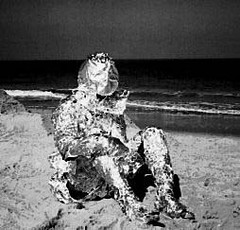I’m Writing About Art Today
As part of my plan for my new life, I will avoid my preoccupation with the “Bush Disaster War,” tax breaks for the wealthy and corporations, and the failing economy. Instead, I will write about Art, at least occasionally. Afterall, I am an artist, and I need to dwell more on my work, the reasons for doing it, ideas about art in general, and other artists whose work is related to my own.
I must confess, however, the scandal over the sexual abuse and torture of Iraqi prisoners has started me to thinking about a possible series of art works in that vein. But, dear Journal, more of that when I have something more concrete.
Duane Michals
Now Becoming Then , is a book of Duane Michals’ photography, a large black volume that I discovered by accident at the Franklin and Marshall College Library in Lancaster, Pennsylvania. The book had been placed casually to the side of the library stacks, and I, being obsessively neat, picked it up in order to return it to the correct location on the shelves. Of course, I was intrigued by the title, and the weight of the tomb, and so began to page through it. Thus began a fascinating inquiry into Michael’s work.
I was pleased to discover a professional photographer of the “fine artist” variety whose work shares some of the same concerns as has mine. First, he works on many different levels. Second, he bridges the transcendental tradition of nineteenth century visual art, the transgressive tradition of Modern Art, and possesses the Postmodern sense of simultaneity, though he creates a sequence with his photographic stories that is not present in my own work. Third, his work addresses his sexuality at least some of the time as does mine. He even built a pyramid as have I (More on my pyramids in the future).
However, Michals uses his own writing within his photographic sequences as a narrative device, which may be historical and/or fictional.
 *
*
Through the written elements and the photographs themselves, Michals seems to inhabit his work. I can’t find the following online, and so I include a detailed description of the photographic essay titled The Return of the Prodigal Son (1982), a series of photographs that tell a story. Here, the artist himself is seen in the role of the father. Michals inhabits the first photograph, reading a newspaper at a round table. Flowers and a reading lamp suggest a domestic scene. The prodigal youth enters the photograph from outside, nude, “bringing nothing with him but his humility, penitence, and need.” *2 In the second and third photographs, Michals undresses and allows the youth to cloth himself in Michals’ clothing. In the final photograph, the youth is clothed, and Michals is nude, which suggests the exchange of innocence for guilt in an Edenesque manner. The exchange of clothing also suggests the initiation of the youth, by his elder into the world of knowledge in the ancient Greek tradition of the mentor/lover relationship between a youth (eromenos) and the older lover ( erastes) as a positive relationship which would serve to inform the youth both intellectually and in battle.*3 Such a relationship is in opposition to the contemporary American politically correct position that defines the ancient Greek ideal as pederasty (sex relations between men and boys). None the less Michals takes a risk, and expresses an erotic desire for the youth, despite the taboo against incest, and sex between older and younger persons (It might be added that the desire is expressed, but the actual consummation of such an act is never demonstrated.) The series of photographs also suggests the wistful desire to go back to the beginning, to exchange the accouterments and ancillary baggage acquired by age, for the clean slate of youth. At the same time, Michals is “the Other,” and simultaneously, in the psychoanalytical sense, he is the youth. He is a dreamlike projection, which he, as the older man, nurtures and protects. Michals uses what at first seems a simple combination of symbolic images involving presence within a space, movement into that space, dress and undress, nudity, an exchange of clothing, youth and old age and, simultaneity. The images, however, taken together, signify a complicated story involving ancient cultural traditions as well as contemporary cultural taboos. Michals’ character is dispersed among the roles his photographs describe, and like a Shakespearian actor, he plays the parts dictated by the culture in which he finds himself, though he is also motivated by the desires within his own person.*4 He manages to transcend cultural limits through a unique vision, and he describes the structure and the limitations of his gayness through this unusual photographic narrative.
The best site found in an on line search for Duane Michals was Kadak’s. Legends Archive.
Also, Studium Zero is in Portuques, but the images are excellent.
Notes
1. “Duane Michals,” Photography at Temple, http://www.temple.edu/photo/photographers/michals/duane.html (visited Saturday, May 1, 2004, 11:42 P.M. EDT)
2. Max Kozloff, Now Becoming Then, (1990) Altadena: Twin Pine Publishers, p. 74-76.
3. K. J. Dover, Greek Homosexuality,(1978) Cambridge: Harvard University Press, pp. 15-17, in Allen Ellenzweig, The Homoerotic Photograph, (1992) New York: Columbia University Press, p. 42.
4. I use the concept of dispersion which includes “the Other,” developed by Michel Foucault in the following works. Naissance de la clinique: une archeologie du regard medical (1963) Paris: Presses Universitaires de France, English translation, The Birth of the Clinic: An archaeology of Medical Perception, translated by A. M. Sheridan Smith. New York: Pantheon, 1973. Les Mots et les choses: une archeologie des science humaines, (1966) Paris: Gallimard, English translation, The Order of Things: An Archaeology of the Human Sciences, translated by Alan Sheridan. (1970) New York: Pantheon.
E-mail me! My e-mail address is ZacSfuts@aol.com.
Visit my homepage
AOL Hometown



0 Comments:
Post a Comment
<< Home